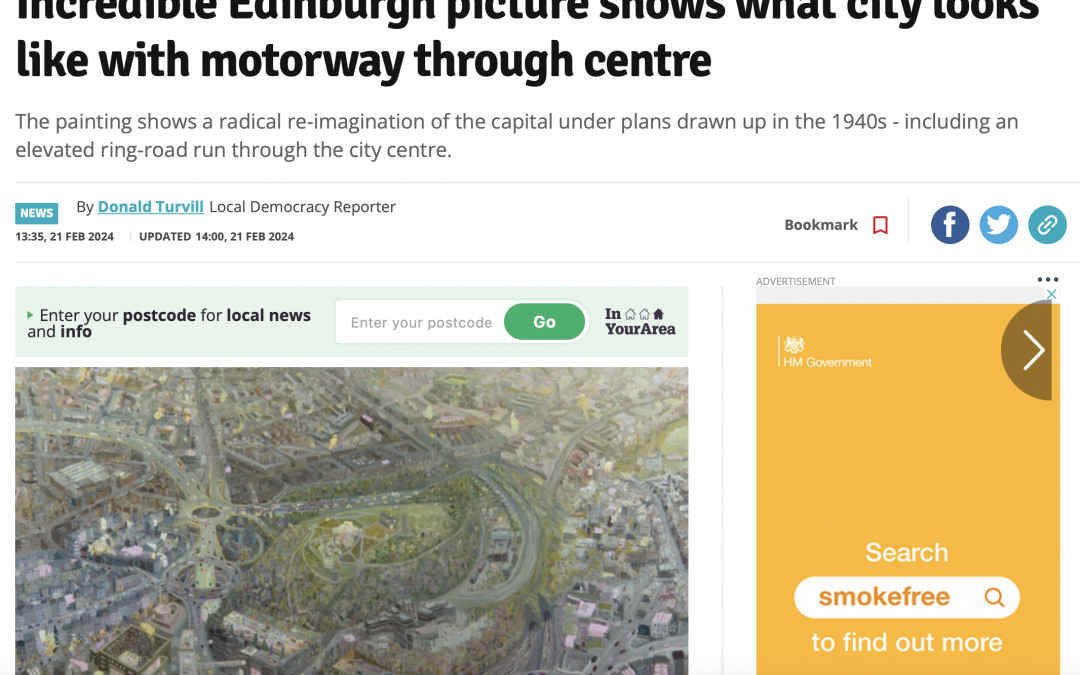There has been a trickle of online press coverage this week as the City of Edinburgh Council meet to vote on whether to acquire my painting, ‘Towards St James and Calton Hill’ which won the City of Edinburgh Purchase Prize at the Scottish Landscape Award at the City Art Centre.
Here are a couple of the articles:
Incredible Edinburgh picture shows what city looks like with motorway through centre
Donald Turvill Local Democracy Reporter (below)
‘An award-winning painting depicting what Edinburgh would have looked like under a controversial plan to run a motorway through the city is to be purchased for the council’s art collection.
Showing a six-lane elevated ring-road tunnelled under Calton Hill and encircling the city centre, the piece is inspired by a vision for the capital’s future drawn up by town planners more than 70 years ago.
After being recognised as the ‘most outstanding view of the city in any media’ at last year’s inaugural Scottish Landscape Awards, Robbie Bushe’s 2023 artwork is set to be bought for the council-owned City Art Centre’s collection for £7,000.
The purchase is set to be confirmed by councillors on Friday, February 23, at a meeting of the Jean F Watson Bequest Committee, which acquires Scottish art for the city’s collection with funds donated by the late art enthusiast.=
The oil painting is based on the 1949 ‘Civic Survey and Plan for the City and Royal Burgh of Edinburgh’ which envisaged the construction of an inner city motorway, which have seen much of the historic Old Town demolished.
While some changes contained within the re-imagination of Edinburgh went ahead – including the construction of a city bypass – the more radical and contentious elements such as the city centre motorway depicted in Bushe’s work, the rebuilding of Princes Street and a freight railway under the Meadows were, were eventually scrapped.
Created by Patrick Abercrombie and Derek Plumstead, who were enlisted to help shape post-war Edinburgh, the ‘Abercrombie Plan’ stated: “A plan for Edinburgh must needs be a hazardous undertaking: there can be few cities towards which the inhabitants display a fiercer loyalty or deeper affection. Even its blemishes are venerated.
“The planner who dares to propose improvements must go warily.”
‘Towards St James and Calton Hill (reimagining the Civic Survey and Plan for the City & Royal Burgh of Edinburgh)’ is part of a series of panoramic paintings by the Liverpool-born artist responding to the survey.
A report to this week’s committee said: “This ambitious historical survey proposed dramatic changes to the topography of central Edinburgh, including a six-lane elevated ring-road encircling the Old and New Towns.
Discover Robbie Bushe’s captivating painting that envisions Edinburgh’s past with a six-lane motorway cutting through its historic core. Explore the intersection of art, history, and urban planning in this thought-provoking piece.
Rizwan Shah 21 Feb 2024 16:36 EST (below)
Imagine the historic heart of Edinburgh, not as the quaint, cobbled streets we know today, but sliced open by a six-lane motorway. This isn’t a scene from a dystopian novel but a vision from the past, brought vividly to life by Robbie Bushe’s award-winning painting. In a remarkable blend of history and imagination, Bushe’s artwork, ‘Towards St James and Calton Hill (reimagining the Civic Survey and Plan for the City & Royal Burgh of Edinburgh)’, presents an Edinburgh that could have been, had city planners in the 1940s had their way. The painting, now poised to become a part of the City Art Centre’s collection, offers a striking commentary on the paths not taken in urban development.
The Vision That Never Was
In the aftermath of World War II, cities around the globe faced the monumental task of rebuilding. Edinburgh was no exception, with the ‘Civic Survey and Plan’ proposing radical changes to its cityscape. At the heart of this plan was a six-lane elevated ring-road, cutting through the city’s Old Town, a proposal based on the visions of Patrick Abercrombie and Derek Plumstead. These changes were aimed at modernizing Edinburgh, but they came at the cost of demolishing much of its historic core. Bushe’s painting captures this controversial vision with an uncanny precision, reimagining the city’s familiar landmarks overshadowed by concrete and traffic.
Bushe’s work, which recently clinched an accolade at the Scottish Landscape Awards, is not just a painting; it’s a portal to an alternate Edinburgh. The city council’s decision to purchase the artwork for £7,000, upon the recommendation of the Jean F Watson Bequest Committee, is a testament to the piece’s profound impact. It’s an acknowledgment of the fine line between preservation and progress that city planners tread, and a nod to the visions that shape our urban landscapes, even those that never come to fruition.
Art, History, and Urban Planning Intersect
The acquisition of Bushe’s painting by the City Art Centre is more than an addition to their collection; it’s a statement on the importance of reflecting on urban planning decisions. By immortalizing a moment in Edinburgh’s planning history that was never realized, the artwork invites viewers to ponder the implications of such transformative changes. It serves as a reminder of the delicate balance between development and the preservation of historical integrity. In doing so, Bushe’s painting becomes a crucial point of conversation in discussions about the future of urban planning and architecture, not just in Edinburgh, but globally.
As Edinburgh continues to evolve, Bushe’s artwork stands as a powerful symbol of the paths we choose and those we leave behind. It challenges us to consider the impact of our decisions on the cityscapes we cherish and the heritage we strive to protect. In capturing a vision of Edinburgh that never was, the painting also immortalizes a moment of reflection on the city that is—a city that, against the odds, managed to retain its historic soul amidst the pressures of modernization.
From Edinburgh
